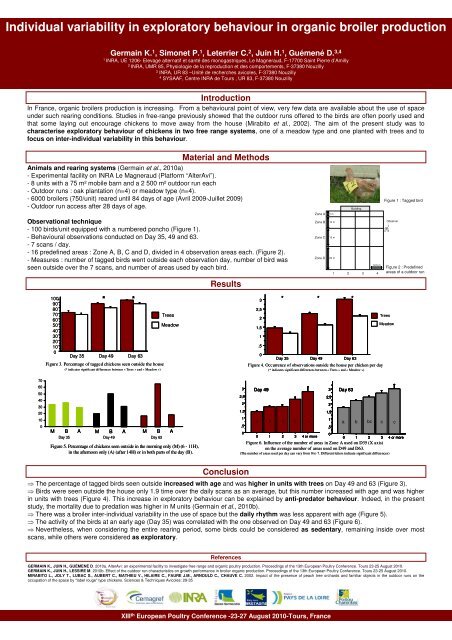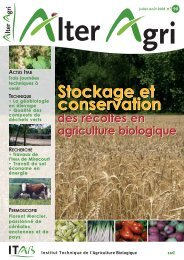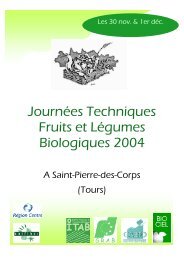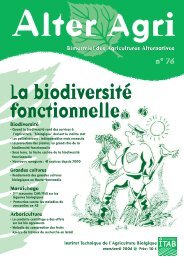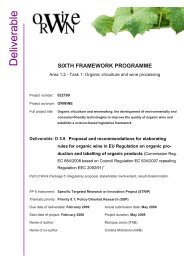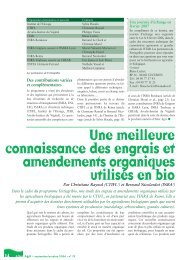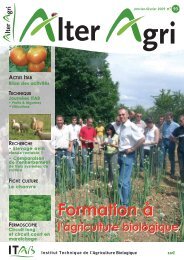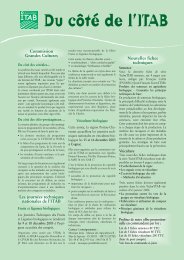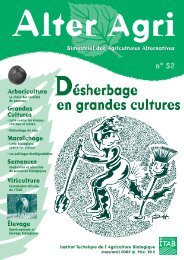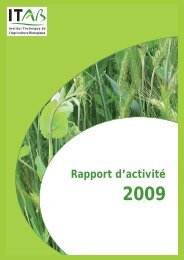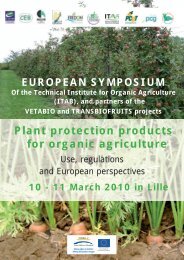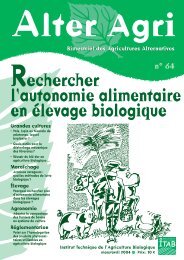Elevage Biologique - Itab
Elevage Biologique - Itab
Elevage Biologique - Itab
Create successful ePaper yourself
Turn your PDF publications into a flip-book with our unique Google optimized e-Paper software.
Individual variability in exploratory behaviour in organic broiler production<br />
Germain K. 1 , Simonet P. 1 , Leterrier C. 2 , Juin H. 1 , Guémené D. 3,4<br />
1<br />
INRA, UE 1206- <strong>Elevage</strong> alternatif et santé des monogastriques, Le Magneraud, F-17700 Saint Pierre d’Amilly<br />
2<br />
INRA, UMR 85, Physiologie de la reproduction et des comportements, F-37380 Nouzilly<br />
3<br />
INRA, UR 83 –Unité de recherches avicoles, F-37380 Nouzilly<br />
4<br />
SYSAAF, Centre INRA de Tours , UR 83, F-37380 Nouzilly<br />
Introduction<br />
In France, organic broilers production is increasing. From a behavioural point of view, very few data are available about the use of space<br />
under such rearing conditions. Studies in free-range previously showed that the outdoor runs offered to the birds are often poorly used and<br />
that some laying out encourage chickens to move away from the house (Mirabito et al., 2002). The aim of the present study was to<br />
characterise exploratory behaviour of chickens in two free range systems, one of a meadow type and one planted with trees and to<br />
focus on inter-individual variability in this behaviour.<br />
Material and Methods<br />
Animals and rearing systems (Germain et al., 2010a)<br />
- Experimental facility on INRA Le Magneraud (Platform “AlterAvi”).<br />
- 8 units with a 75 m² mobile barn and a 2 500 m² outdoor run each<br />
- Outdoor runs : oak plantation (n=4) or meadow type (n=4).<br />
- 6000 broilers (750/unit) reared until 84 days of age (Avril 2009-Juillet 2009)<br />
- Outdoor run access after 28 days of age.<br />
Observational technique<br />
- 100 birds/unit equipped with a numbered poncho (Figure 1).<br />
- Behavioural observations conducted on Day 35, 49 and 63.<br />
- 7 scans / day.<br />
- 16 predefined areas : Zone A, B, C and D, divided in 4 observation areas each. (Figure 2).<br />
- Measures : number of tagged birds went outside each observation day, number of bird was<br />
seen outside over the 7 scans, and number of areas used by each bird.<br />
100<br />
90<br />
80<br />
70<br />
60<br />
50<br />
40<br />
30<br />
20<br />
10<br />
0<br />
* *<br />
Day 35 Day 49 Day 63<br />
Figure 3. Percentage of tagged chickens seen outside the house<br />
(* indicates significant differences between « Trees » and « Meadow »)<br />
Trees<br />
Meadow<br />
Results<br />
3<br />
2,5<br />
2<br />
1,5<br />
1<br />
,5<br />
0<br />
Zone A<br />
Zone B<br />
Zone C<br />
Zone D<br />
5 m<br />
10 m<br />
15 m<br />
20 m<br />
* * *<br />
Building<br />
12,5 m<br />
1 2 3 4<br />
Day 35 Day 49 Day 63<br />
Figure 4. Occurrence of observations outside the house per chicken per day<br />
(* indicates significant differences between « Trees » and « Meadow »)<br />
Figure 1 : Tagged bird<br />
Observer<br />
Figure 2 : Predefined<br />
areas of a outdoor run<br />
Trees<br />
Meadow<br />
70<br />
60<br />
50<br />
40<br />
30<br />
20<br />
10<br />
0<br />
M B A<br />
M B A M B A<br />
Day 35 Day 49 Day 63<br />
Figure 5. Percentage of chickens seen outside in the morning only (M) (6 - 11H),<br />
in the afternoon only (A) (after 14H) or in both parts of the day (B).<br />
3<br />
Day 49<br />
3<br />
Day 63<br />
2,5<br />
2,5<br />
2<br />
2<br />
1,5<br />
1,5<br />
1<br />
a b b c c 1<br />
a b bc c c<br />
,5<br />
,5<br />
0<br />
0<br />
0 1 2 3 4 or more<br />
0 1 2 3 4 or more<br />
Figure 6. Influence of the number of areas in Zone A used on D35 (X axis)<br />
on the average number of areas used on D49 and D63.<br />
(The number of areas used per day can vary from 0 to 7. Different letters indicate significant differences)<br />
Conclusion<br />
⇒ The percentage of tagged birds seen outside increased with age and was higher in units with trees on Day 49 and 63 (Figure 3).<br />
⇒ Birds were seen outside the house only 1.9 time over the daily scans as an average, but this number increased with age and was higher<br />
in units with trees (Figure 4). This increase in exploratory behaviour can be explained by anti-predator behaviour. Indeed, in the present<br />
study, the mortality due to predation was higher in M units (Germain et al., 2010b).<br />
⇒ There was a broiler inter-individual variability in the use of space but the daily rhythm was less apparent with age (Figure 5).<br />
⇒ The activity of the birds at an early age (Day 35) was correlated with the one observed on Day 49 and 63 (Figure 6).<br />
⇒ Nevertheless, when considering the entire rearing period, some birds could be considered as sedentary, remaining inside over most<br />
scans, while others were considered as exploratory.<br />
References<br />
GERMAIN K., JUIN H., GUÉMENÉ D. 2010a. AlterAvi: an experimental facility to investigate free range and organic poultry production. Proceedings of the 13th European Poultry Conference. Tours 23-25 August 2010.<br />
GERMAIN K., JUIN H., LESSIRE M. 2010b. Effect of the outdoor run characteristics on growth performance in broiler organic production. Proceedings of the 13th European Poultry Conference. Tours 23-25 August 2010.<br />
MIRABITO L., JOLY T., LUBAC S., AUBERT C., MATHIEU V., HILAIRE C., FAURE J.M., ARNOULD C., CHAUVE C. 2002. Impact of the presence of peach tree orchards and familiar objects in the outdoor runs on the<br />
occupation of the space by "label rouge" type chickens. Sciences & Techniques Avicoles: 29-35<br />
XIII th European Poultry Conference -23-27 August 2010-Tours, France


